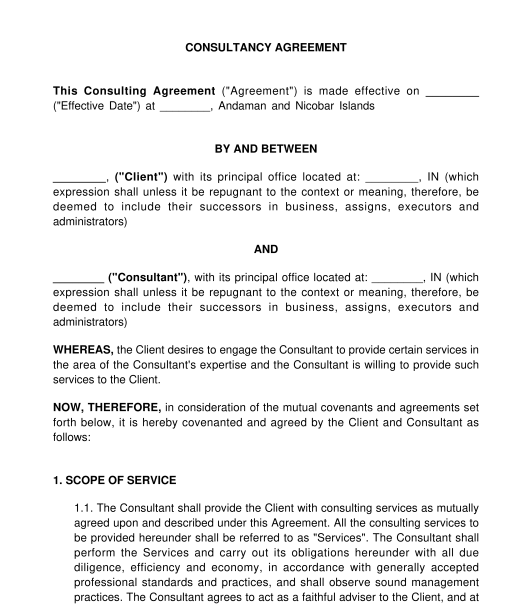 03-10-2025
03-10-2025

Answer a few questions and your document is created automatically.

Your document is ready! You will receive it in Word and PDF formats. You will be able to modify it.

 03-10-2025
03-10-2025
 Word and PDF
Word and PDF
 7 to 10 pages
7 to 10 pages
A Consultancy Agreement is a contract under which the terms of service between a Consultant and the Client are defined. This Agreement can be used when an individual or a business entity avails of the services of the Consultant or independent contractor.
This Consultancy Agreement can be used in different scenarios including the following:
The Consultancy Agreement establishes the business relationship between the parties. In contrast to a standard employment agreement, the relationship between the Client and Consultant will be that of an independent contractor. As opposed to an employee, the Consultant will have greater flexibility in completing assigned tasks.
An employee is obligated to follow the employer's instructions strictly and is subject to greater control by the employer. Unlike employees, consultants are not entitled to benefits provided under various central and state laws, such as provident funds, pension funds, insurance schemes, employee state insurance, workman's compensation, gratuity, bonuses, maternity benefits, leaves, and holidays.
For more information on the distinction between these two agreements, please refer to our guide: "What is the difference between an Employee and an Independent Contractor?"
In Consultancy Agreement, the relationship is typically advisory, with an external consultant offering expert guidance, and solutions. The focus is on delivering advice, analysis or recommendations. On the other hand, a Service Agreement involves ongoing or regular work such as support, maintenance, etc.
In comparison to the Consultancy Agreement, under the Service Agreement, the Client will have more control and commanding power over the service provider.
As far as payments are concerned, the consultants are paid based on the specific work, or an hourly basis. On the other hand, the service provider is paid a recurring payment.
No, it is not mandatory. However, a properly drafted Consultancy Agreement is essential to avoid any disputes or settling the disputes between the Consultant and the Client.
Any individual above the age of 18 years or entity registered in India can enter into a Consultancy Agreement.
The duration of the Consultancy Agreement varies based on the nature of the project. It can be for a duration of a few months or a few years. It can also be for an indefinite period unless terminated by either party in accordance with the Consultancy Agreement.
Once prepared the Consultancy Agreement should be printed on non-judicial stamp paper or e-stamp paper, and signed by both the consultant and the client. The value of the stamp paper would depend on the state in which it is executed. Each state in India has provisions in respect of the amount of stamp duty payable on such agreements. Information regarding the stamp duty payable can be found on the State government websites.
Once all parties have signed, both the consultant and the client should keep a signed copy of the Consultancy Agreement. To do this, two different copies can be signed, or if only one copy is signed, it can be photocopied and then distributed between the parties.
Yes, it is necessary. An independent adult must witness each party's signature, someone over 18 years old, who is not involved with the agreement. Thus, the parties cannot witness each other.
To have an additional protection, the following documents can be attached along with the Consultancy Agreement:
- Non-Disclosure Agreement: If the parties want to fix more complete provisions concerning the confidentiality obligation (for instance: what should and should not be considered confidential information, for how long should they be kept confidential, etc.), they can sign a separate Non-Disclosure Agreement; and/or
- Non-Compete Agreement: if the parties want to have a detailed agreement to restrict the consultant from competing with the Client for a particular period in a specific region.
Yes, a Consultancy Agreement can be terminated. The Consultancy Agreement is mainly terminated on the following grounds:
The Consultancy Agreement must include the following clauses:
Consultancy Agreements are regulated and enforceable under the Indian Contract Act, 1872.
You fill out a form. The document is created before your eyes as you respond to the questions.
At the end, you receive it in Word and PDF formats. You can modify it and reuse it.
A guide to help you: What to do after Finishing a Contract?
Consultancy Agreement - Sample, template - Word and PDF
Country: India